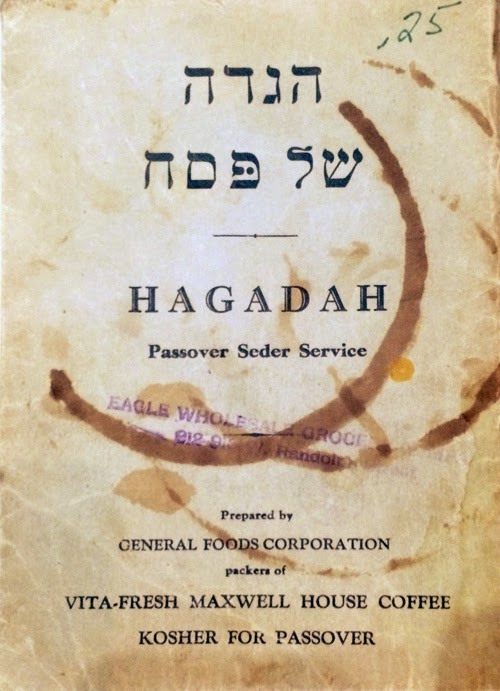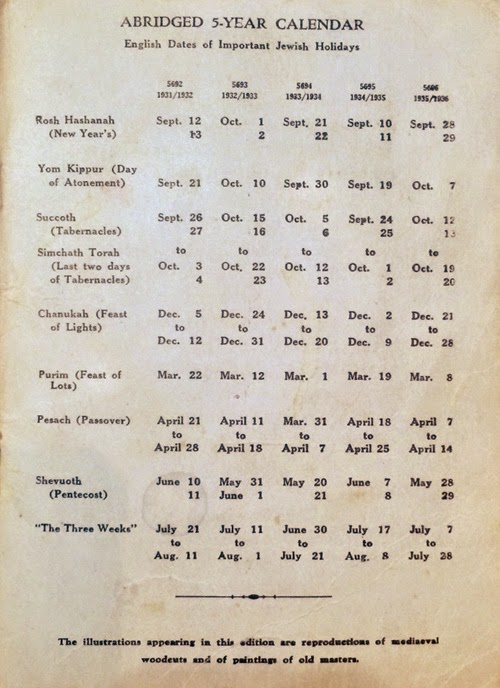On the Maxwell House Haggadah
For contemporary American Jews, it is not an exaggeration to claim the Maxwell House Haggadah, as one of the most commonly used and widely known haggadahs. Even President Obama was aware of this history when he quipped regarding another recent haggadah “does this mean we can no longer use the Maxwell House Haggadah anymore?”

The first Maxwell House sponsored haggadah was published in 1932. [1] The Haggadah wasn’t published btwetween 1941 and 1948, but otherwise has been consistently published yearly, if in a changed format. In the early years, the editions were nearly the same with the only substantive change to update the included five-year calender. The sameness perhaps explains why the New York Times in two different articles accompanied by the identical photograph of the Maxwell House Haggdah, captions one 1932 and the other 1934.
The 1932 date is confirmed by the Maxwell House advertising campaign that included the Haggadah.
Maxwell House was not the first corporate sponsored haggadah, there were many before it. For example, the West Side National Bank in Chicago sponsored one in 1919, which was printed in both Yiddish and English versions. Sometime in the 1920s, the American National Bank in Newark (whose name appeared in English and Yiddish) sponsored a haggadah, this one included both Hatikvah and the Star Spangled Banner (a common occurrence in many haggadahs published in America). Numerous other banks sponsored haggadas throughout the 1920s. Postum, a coffee “substitute” put out its own haggdah in 1935, by then Postum was also part of the General Foods’ portfolio.
In 1929, Yeshiva Chaim Berlin sponsored one as “a token of gratitude to its donors.” The Haggadah was in Hebrew and English with a Yiddish introduction. The Haggadah also contains an image that includes a star of David flanked by the flag of the United States and the Zionist flag.
– although in the introduction the editors write that the haggadah was distributed “in the fervent hope that this token will serve as a reminder of [the recipient’s] holy obligation to help the Yeshiva and assist in the undertaking to erect the new building.” It includes illustrations of the Zionist and American flags, every teacher/rabbi pictured is beardless, and there are numerous pictures of the classrooms, many of which have a portrait of Lincoln hanging. Finally, it contains “a brief survey of the Yeshiva Rabbi Chaim Berlin, founded in 1912.” [By 1970, Yeshiva Chaim Berlin sponsored/published five haggadahs. See Yudolov, Otzar ha-Haggadaot, index, sub. Yeshiva Chaim Berlin.]
Some corporate sponsorships tied in more directly to the food and drink of Peasach, wine and meat. For example, Hebrew National meat products sponsored a haggadah. Mogen David wines sponsored a haggadah in the 1920’s.(It is lacking a date, however, Yudolov, Otzar ha-Haggadot, no. 2807, dates it to “192-”. If Yudolov is correct, then Pinney’s dating of the use of brand Mogen David to 1947, needs to be corrected. Thomas Pinney, A History of Wine in America, Univ. of Calif. Press, 2005, 174.) Similarly, Another wine company, Schapiro’s House of Kosher Wines, California Wine Company, sponsored one in 1941. And the Manischewitz Company, got into the haggadah sponsorship game in 1943. While Striets[‘] Matza sponsored one in 1945.
Nor was this practice limited to sponsorship of Hebrew publications. In 1900, Chase & Sanborn, then one of the largest US coffee concerns, issued a booklet, by one of its owners, to promote its Seal brand coffee, After Dinner Tricks and Puzzles with Your Seal Brand Coffee. Among the brainteasers was “how many hard boiled eggs can a hungry man eat on an empty stomach?” Answer: One only, for after eating one, his stomach would no longer be empty.” [The booklet also included illustrations and language that through a contemporary lens would be viewed as racist and misogynistic.]
The first edition of the Maxwell House Haggadah was issued in 1932, see supra. (The origin of the company’s name is that a roaster began selling his beans to a prestigious Nashville hotel, Maxwell House, creating a name that is similar to sponsorship.) It contains illustrations that are “reproductions of mediaeval woodcuts and of paintings of old masters.” The illustrations are neither reproductions of woodcuts or mediaeval, instead, the illustrations can be dated to the 18th and 19th centuries and they were printed with modern techniques.
The sponsorship is indicated on a plain paper cover, “prepared by General Foods Corporation packers of Vita-Fresh Maxwell House Coffee Kosher for Passover” (General Foods appears in smaller type than Maxwell House). This later changed to a more colorful cover. The anonymous introduction is written from the perspective of General Foods. The introduction explains the rational for sponsoring this haggadah that “General Foods Corporation, packers of Maxwell House Coffee, whose relations with the Jewish people have always been most friendly, take pleasure in presenting this new, up-to-date edition of The Haggadah.” Aside from General Foods touting its relationship with “the Jewish people” there were other reasons General Foods likely sponsored the haggadah. After the stock market crash in 1929, Maxwell House lost considerable market share. And, in 1932, General Foods switched its advertising agency to Benton & Bowles, in the hope of turning around Maxwell House sales. To further this revamped advertising strategy, General Foods “allotted a whopping $3.1 million . . . to advertise Maxwell House.” And with this advertising dollars, came sponsorships. The most notable sponsorship was that of a radio show, the Maxwell House Show Boat, that turned into an enormous success greatly increasing it market share, and, the haggada, while perhaps then a lesser known sponsorship, ironically, today it is more well known.
Turning to the advertising aspect of the haggadah, aside from the sponsorship, the final page is a full page ad for Maxwell House and, like the title page, touts the “vita-fresh process” which “assures of full flavor and deliciousness. Not a trace of air remains in the can to cause loss of flavor or deterioration.” General Foods’ vacuum technique, vita-fresh, was introduced in 1931 to counter Chase & Sanborn’s earlier adoption of vacuum for its coffee and its accompanying advertisements proclaiming that without vacuum the coffee produces “rancid oil” which was “the cause of indigestion, headaches, sleeplessness,” an implicit criticism of Maxwell House. [Chase & Sunborn were not even the first to adopt this technology. Instead, the Hill Brothers pioneered the use of vacuum to preserve coffee freshness in 1900, Chase wouldn’t adopt it until the late 1920s and Maxwell House in the 1930s.] Ultimately, as mentioned above, vita-fresh didn’t save Maxwell House, it was the radio show. Thus, in the second edition of the Maxwell House, it no longer mentions vita-fresh.
There were many companies that sponsored haggadahs in the early twentieth century, today only Maxwell House survives. To account for that longevity it is helpful to keep in mind the unique conditions that led to Maxwell House’s sponsorship — the increase focus on advertising. The other corporate sponsorships, all predate the stock market crash and subsequent Depression. While there is no direct evidence, it is likely that those companies reduced their advertising budgets and with that went their haggadah sponsorship. Maxwell House, however, began its sponsorship after the stock market crash and its sponsorship remained undisturbed by external economic forces, remaining the last survivor of the early Twentieth Century corporate sponsors of the Haggadah.
Notes
[1] See Yudolov, Otzar ha-Haggadot no. 3428. Although the title page does not provide a date, the Haggadah includes a five-year Hebrew calendar. Thus, to date the Haggadah, the first year indicated in the calendar is used as a proxy for the date of publication. The first edition includes a calendar beginning in 1932, the next edition begins with 1933, and so on. See Yudolov, nos. 3428, 3455, 3489, 3594, 3620, 3656, 3689, 3721.
References
Haggadah: Yudolov, Otzar ha-Haggadot, Magnus Press, Jerusalem [n.d]; Goldman, Hebrew Printing in America, Brooklyn, NY:2006, no. 170; Yaari, Bibliography of the Passover Haggadah, Bamberer & Wahrman, Jerusalem, 1960.
Coffee: Pendergrast, Uncommon Grounds, Basic Book, USA, 1999, 125, 191-96.
For an survey of coffee, see Modernist Cuisine, The Cooking Lab, Washington:2011, vol. IV, 357-403.
The most comprehensive book discussing how to brew (excellent) coffee using a variety of methods, see Scott Rao, Everything but Espresso, Professional Coffee Brewing Techniques, Canada, 2010.



